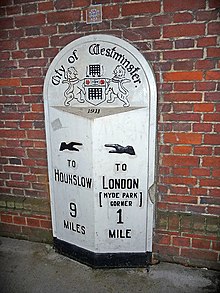unit of length (on ground) From Wikipedia, the free encyclopedia
A mile is a unit of length. There are many different kinds of mile but mile on its own usually means the statute mile.
| Mile | |
|---|---|
 The distance between Westminster and London is 1 mile | |
| General information | |
| Unit system | English unit |
| Unit of | length |
| Symbol | mi or m |
| Conversions | |
| 1 mi in ... | ... is equal to ... |
| SI units | 1609.344 m |
| imperial/US units | |
| nautical units | 0.86898 nmi |
In the US and the UK the word mile usually means the statute mile.
| Feet | Yard | Chain | Furlong | Mile | Kilometres |
|---|---|---|---|---|---|
| 5,280 | 1,760 | 80 | 8 | 1 | 1.609344 |
The nautical mile is used for sea or air travel.
The nautical mile was originally defined as one minute of arc along a line of longitude of the Earth. There are 60 minutes of arc in one degree or arc (60' = 1°). So there were 10,800 nautical miles from the North Pole to the South Pole.
Now the nautical mile is defined as 1,852 metres.
| 1 nautical mile | = 1,852 metres (by definition) |
| ≈ 6,076 feet | |
| ≈ 1.151 statute miles |
The speed of a ship that travels one nautical mile in one hour is called one knot
The mile was first used by the Romans. It comes from the Latin phrase mille passus (plural: milia passuum). This means "one thousand paces". A pace is the distance each foot moves when taking one step.
“the Roman pace, measured from the heel of one foot to the heel of the same foot in the next stride”[1]
| 1 Roman mile | = 1,000 Roman paces (by definition) |
| ≈ 1,479 metres | |
| ≈ 4,852 feet |
Different miles have been used throughout history in various parts of the world. In Norway and Sweden, for example, a mil is a unit of length which is equal to 10 kilometres.
Even in English-speaking countries that use the metric system (for example, Australia, Canada, and New Zealand), the mile is still used in many idioms. These include:
Seamless Wikipedia browsing. On steroids.
Every time you click a link to Wikipedia, Wiktionary or Wikiquote in your browser's search results, it will show the modern Wikiwand interface.
Wikiwand extension is a five stars, simple, with minimum permission required to keep your browsing private, safe and transparent.